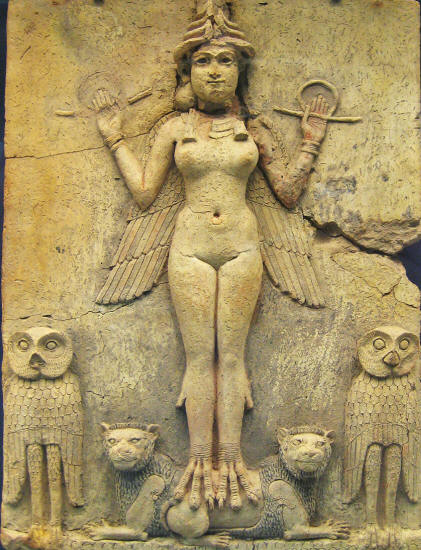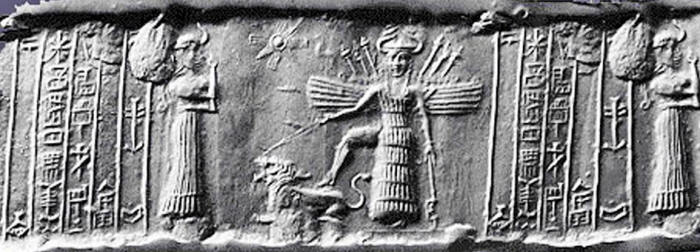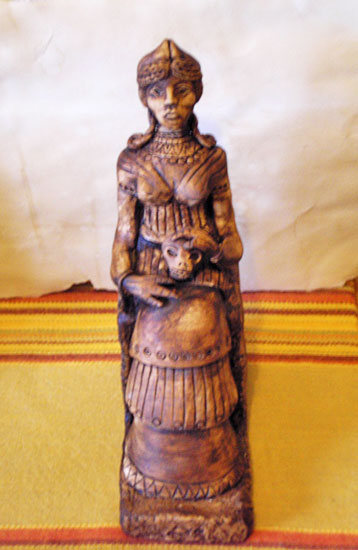|

March 16, 2017
from
AncientPages Website
Spanish
version
Ereshkigal, a granddaughter of Enlil, is the queen of
the underworld or
Irkalla (the land of the dead).
She is older sister
of Inanna (later known as Ishtar)
and wife of Nergal, the king of death who brings disease, plague,
and all misfortunes caused by heat.
Ereshkigal, whose name means "Queen of the Great Below", is very
powerful ruler in her kingdom of the dead and her judgment and laws
are always indisputable.

Ishtar/Inanna
or possibly female demon Lilith,
attended by
owls and lions.
2025-1763 BC,
terracotta relief panel, 51 cm,
Norman Colville
Collection, London.
Credits:
ARTstor
http://library.artstor.org
Ereshkigal Was
Given The Underworld For Her Domain
In Sumerian religion, in the very beginning, the universe was
divided into three regions each of which became the domain of a god.
Anu, Sky Father, was also
"King of the Gods",
"Lord of the
Constellations, Spirits and Demons", and "Supreme Ruler of the
Kingdom of Heaven", which was his domain.
The earth was given to
Enlil. Ea became the ruler of
the waters...
Together they constituted the triad of the Great Gods.
According to the
Epic of Gilgamesh (c.1850 BC),
Ereshkigal was,
"given the underworld
for her domain" and she became the ruler of the Underworld.
However, in another story
(similar to that of Ovid's tale of Hades' and abduction of the
goddess Persephone), Ereshkigal is kidnapped by her half-brother,
the dragon Kur, and taken to the underworld where she is made queen.
Inanna
Descends to Gloomy Kingdom of The Dead
No one could ever question her decisions and those who enter her
world can no longer return to the world of the living.

Descent of Inanna to the Underworld
and the
ancient Sumerian Goddess
of the
Great Below, Ereshkigal
The Kingdom of Ereshkigal is a gloomy land of shadows, with no
future and no hope. To this abyss of hopelessness are thrown not
only sinners but also good and bad, great and small, God-fearing
people and blasphemers.
All of them become powerless and pale
forever.
The exception is
Inanna, the goddess of life and fertility, whose
descent to Ereshkigal's underworld is believed to be one of the most
known Sumerian myths.
Inanna and Ereshkigal
have never been good friends. Moreover, Inanna enters
the underworld in an unsuccessful attempt to deceitfully take power
over the abyss of Ereshkigal.
She is punished by her and killed and her corpse hangs on a hook.
It seems that even gods
who try to convince Ereshkigal to release Inanna, are powerless to
help, because in the underworld, there are rules and principles,
which have to be followed.

Ereshkigal
Finally Ereshkigal gives Inanna's corpse to the gods, and they
revive the goddess with water of life and food.
Inanna ascends to the
upper world, but must send someone down to take her place in the
land of the dead. She decides to send her husband, Dumuzi as the
substitution because Dumuzi is the one who has not mourned her
death.
Appearance of Ereshkigal is not exactly known.
The Akkadians associated her with their own Semitic underworld
goddess, Allatum. There is, however, a rectangular, fired clay
relief panel depicting a naked woman standing on two lions and
flanked by owls, holding a rod and ring in her hands.
These two symbols are often depicted on Mesopotamian stelas,
cylinder seals and reliefs.
Whether this panel depicts Inanna or Ereshkigal is still under
debate. It has even been proposed that it may represent female demon
Lilith.
With few exceptions, Ereshkigal had no cult center in Mesopotamia
and as a result, she is only occasionally encountered outside the
literature. Inscriptions confirm that temples dedicated to her
existed in,
Her coalition government with
Nergal begins in the old-Babylonian
period (1830 - 1531 BC).
During the first
millennium BC, Nebuchadnezzar II - a Chaldean king of the
Neo-Babylonian Empire, who reigned c. 605 BCE - c. 562 BC - rebuilt
her temple in Kutha (Cuthah).
|




